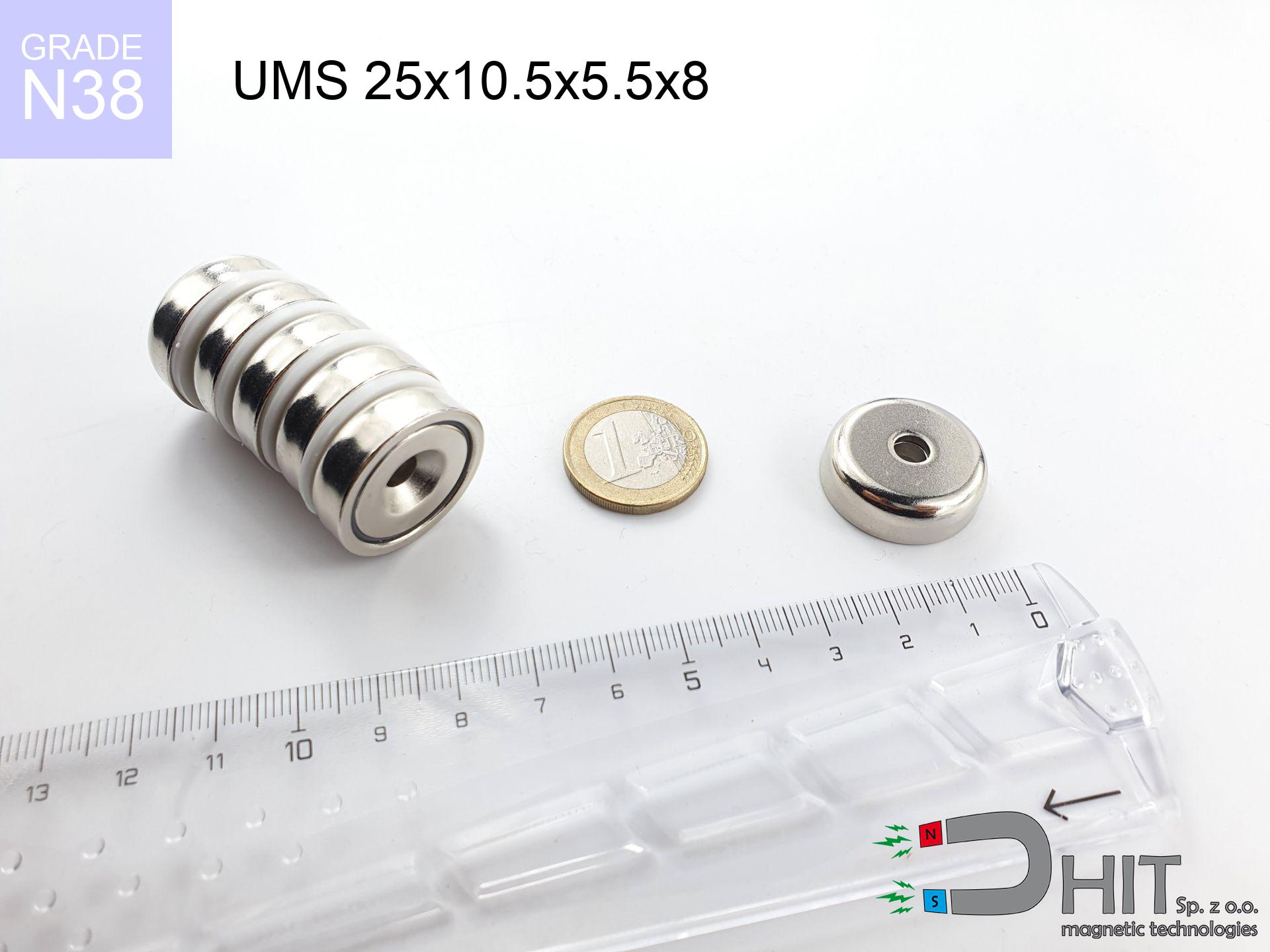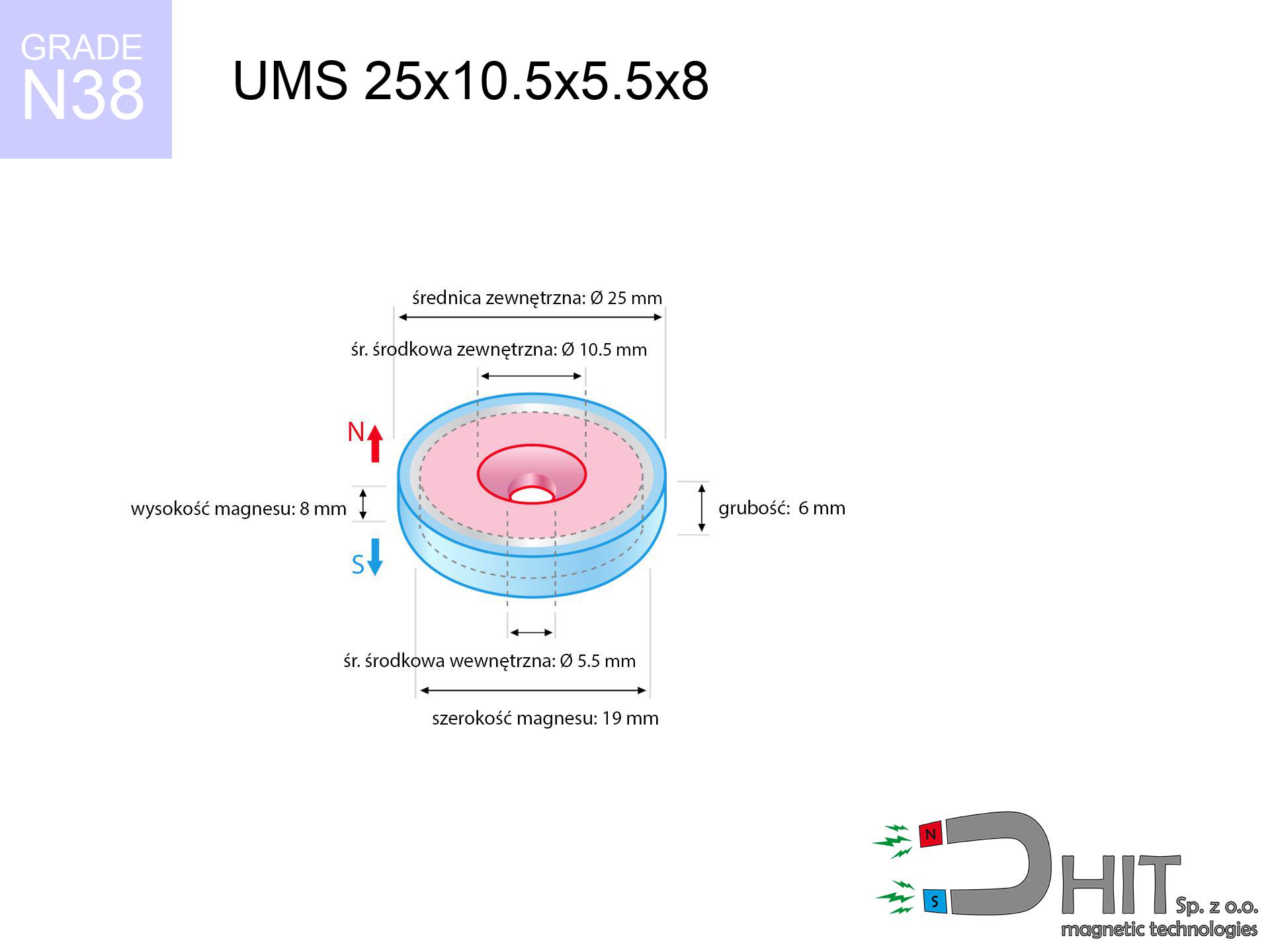UMS 25x10.5x5.5x8 / N38 - conical magnetic holder
conical magnetic holder
Catalog no 220328
GTIN/EAN: 5906301814184
Diameter Ø
25 mm [±1 mm]
cone dimension Ø
10.5x5.5 mm [±1 mm]
Height
8 mm [±1 mm]
Weight
21 g
Magnetization Direction
↑ axial
Load capacity
14.00 kg / 137.29 N
Coating
[NiCuNi] Nickel
9.72 ZŁ with VAT / pcs + price for transport
7.90 ZŁ net + 23% VAT / pcs
bulk discounts:
Need more?
Contact us by phone
+48 888 99 98 98
alternatively send us a note using
request form
through our site.
Lifting power along with structure of a magnet can be reviewed on our
magnetic calculator.
Orders submitted before 14:00 will be dispatched today!
Detailed specification - UMS 25x10.5x5.5x8 / N38 - conical magnetic holder
Specification / characteristics - UMS 25x10.5x5.5x8 / N38 - conical magnetic holder
| properties | values |
|---|---|
| Cat. no. | 220328 |
| GTIN/EAN | 5906301814184 |
| Production/Distribution | Dhit sp. z o.o. |
| Country of origin | Poland / China / Germany |
| Customs code | 85059029 |
| Diameter Ø | 25 mm [±1 mm] |
| cone dimension Ø | 10.5x5.5 mm [±1 mm] |
| Height | 8 mm [±1 mm] |
| Weight | 21 g |
| Magnetization Direction | ↑ axial |
| Load capacity ~ ? | 14.00 kg / 137.29 N |
| Coating | [NiCuNi] Nickel |
| Manufacturing Tolerance | ±1 mm |
Magnetic properties of material N38
| properties | values | units |
|---|---|---|
| remenance Br [min. - max.] ? | 12.2-12.6 | kGs |
| remenance Br [min. - max.] ? | 1220-1260 | mT |
| coercivity bHc ? | 10.8-11.5 | kOe |
| coercivity bHc ? | 860-915 | kA/m |
| actual internal force iHc | ≥ 12 | kOe |
| actual internal force iHc | ≥ 955 | kA/m |
| energy density [min. - max.] ? | 36-38 | BH max MGOe |
| energy density [min. - max.] ? | 287-303 | BH max KJ/m |
| max. temperature ? | ≤ 80 | °C |
Physical properties of sintered neodymium magnets Nd2Fe14B at 20°C
| properties | values | units |
|---|---|---|
| Vickers hardness | ≥550 | Hv |
| Density | ≥7.4 | g/cm3 |
| Curie Temperature TC | 312 - 380 | °C |
| Curie Temperature TF | 593 - 716 | °F |
| Specific resistance | 150 | μΩ⋅cm |
| Bending strength | 250 | MPa |
| Compressive strength | 1000~1100 | MPa |
| Thermal expansion parallel (∥) to orientation (M) | (3-4) x 10-6 | °C-1 |
| Thermal expansion perpendicular (⊥) to orientation (M) | -(1-3) x 10-6 | °C-1 |
| Young's modulus | 1.7 x 104 | kg/mm² |
Material specification
| iron (Fe) | 64% – 68% |
| neodymium (Nd) | 29% – 32% |
| boron (B) | 1.1% – 1.2% |
| dysprosium (Dy) | 0.5% – 2.0% |
| coating (Ni-Cu-Ni) | < 0.05% |
Ecology and recycling (GPSR)
| recyclability (EoL) | 100% |
| recycled raw materials | ~10% (pre-cons) |
| carbon footprint | low / zredukowany |
| waste code (EWC) | 16 02 16 |
View also deals
Strengths as well as weaknesses of rare earth magnets.
Strengths
- They virtually do not lose power, because even after 10 years the decline in efficiency is only ~1% (based on calculations),
- They are noted for resistance to demagnetization induced by external disturbances,
- Thanks to the metallic finish, the surface of Ni-Cu-Ni, gold, or silver gives an visually attractive appearance,
- They are known for high magnetic induction at the operating surface, which improves attraction properties,
- Thanks to resistance to high temperature, they are capable of working (depending on the form) even at temperatures up to 230°C and higher...
- Due to the option of free shaping and customization to individualized projects, magnetic components can be produced in a broad palette of geometric configurations, which increases their versatility,
- Huge importance in electronics industry – they are commonly used in mass storage devices, electric motors, medical equipment, and multitasking production systems.
- Relatively small size with high pulling force – neodymium magnets offer high power in compact dimensions, which makes them useful in small systems
Disadvantages
- To avoid cracks under impact, we recommend using special steel housings. Such a solution secures the magnet and simultaneously improves its durability.
- When exposed to high temperature, neodymium magnets suffer a drop in power. Often, when the temperature exceeds 80°C, their power decreases (depending on the size and shape of the magnet). For those who need magnets for extreme conditions, we offer [AH] versions withstanding up to 230°C
- Due to the susceptibility of magnets to corrosion in a humid environment, we suggest using waterproof magnets made of rubber, plastic or other material resistant to moisture, in case of application outdoors
- Due to limitations in realizing nuts and complicated forms in magnets, we propose using cover - magnetic mount.
- Possible danger resulting from small fragments of magnets can be dangerous, in case of ingestion, which is particularly important in the context of child safety. Additionally, tiny parts of these devices can disrupt the diagnostic process medical after entering the body.
- High unit price – neodymium magnets cost more than other types of magnets (e.g. ferrite), which increases costs of application in large quantities
Holding force characteristics
Optimal lifting capacity of a neodymium magnet – what it depends on?
- on a base made of structural steel, perfectly concentrating the magnetic flux
- whose transverse dimension reaches at least 10 mm
- with an ideally smooth touching surface
- under conditions of no distance (metal-to-metal)
- for force acting at a right angle (in the magnet axis)
- at ambient temperature room level
Lifting capacity in practice – influencing factors
- Clearance – existence of any layer (paint, dirt, gap) interrupts the magnetic circuit, which lowers capacity steeply (even by 50% at 0.5 mm).
- Direction of force – highest force is reached only during pulling at a 90° angle. The shear force of the magnet along the surface is standardly several times lower (approx. 1/5 of the lifting capacity).
- Wall thickness – thin material does not allow full use of the magnet. Magnetic flux penetrates through instead of converting into lifting capacity.
- Material composition – different alloys reacts the same. Alloy additives worsen the interaction with the magnet.
- Surface quality – the smoother and more polished the plate, the larger the contact zone and stronger the hold. Roughness acts like micro-gaps.
- Thermal factor – high temperature reduces pulling force. Exceeding the limit temperature can permanently damage the magnet.
Lifting capacity was determined by applying a smooth steel plate of optimal thickness (min. 20 mm), under vertically applied force, whereas under parallel forces the load capacity is reduced by as much as 75%. In addition, even a minimal clearance between the magnet and the plate decreases the load capacity.
Safe handling of neodymium magnets
Crushing risk
Large magnets can break fingers in a fraction of a second. Do not put your hand betwixt two strong magnets.
Operating temperature
Avoid heat. NdFeB magnets are susceptible to heat. If you require resistance above 80°C, ask us about HT versions (H, SH, UH).
Threat to navigation
Note: neodymium magnets produce a field that interferes with sensitive sensors. Maintain a safe distance from your phone, device, and GPS.
Eye protection
Beware of splinters. Magnets can explode upon uncontrolled impact, ejecting shards into the air. Wear goggles.
Life threat
Medical warning: Neodymium magnets can turn off pacemakers and defibrillators. Stay away if you have electronic implants.
Safe operation
Exercise caution. Rare earth magnets attract from a distance and connect with huge force, often faster than you can react.
Choking Hazard
Strictly keep magnets away from children. Ingestion danger is significant, and the consequences of magnets clamping inside the body are fatal.
Keep away from computers
Do not bring magnets close to a wallet, computer, or screen. The magnetic field can permanently damage these devices and wipe information from cards.
Metal Allergy
Warning for allergy sufferers: The nickel-copper-nickel coating consists of nickel. If skin irritation happens, immediately stop handling magnets and use protective gear.
Fire warning
Dust created during cutting of magnets is self-igniting. Avoid drilling into magnets without proper cooling and knowledge.






![SM 25x300 [2xM8] / N52 - magnetic separator SM 25x300 [2xM8] / N52 - magnetic separator](https://cdn3.dhit.pl/graphics/products/sm-25x300-2xm8-dij.jpg)


